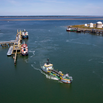More and deeper: dredging amid sanctions
The capacity of Russian seaports increased by 37 million tonnes in 2022. In the coming years it is to show further growth with the implementation of large-scale projects in all basins of the country. A considerable scope of hydraulic engineering works is to be conducted on inland water ways. However, it is necessary to create our own dredging fleet for implementation of those projects.
Numerous plans
Russia’s port infrastructure the capacity of which is estimated at 1.64 billion tonnes today will see the development in the coming years. There are infrastructure projects covering all basins of the country.
In the North-West Region, Russia will build up the capacity of dry bulk terminals. In the Kaliningrad Region, the construction of a passenger ferry terminal is underway in Pionersky. In the Arctic, the existing ports are being reconstructed and new projects aimed at transportation of LNG, coal and ores are being implemented. In the Southern Basin, the capacity of ports is to be boosted for handling general and dry bulk cargo. In the Far East, current projects are focused on handling of containers, coal and LNG.
There is a plan to develop fish terminals in Makhachkala, Vladivostok, Nakhodka, Kamchatka and Sakhalin.
Considerable works are to be performed on inland water ways of Russia.
To implement all the announced plans it is necessary to perform an essential scope of dredging works which represent the most challenging and costly part of most projects.
In Russia, the customers of dredging works are FSUE Rosmorport (in most of seaports of Russia), Rosatom’s FSUE Hydrographic Company (Northern Sea Route infrastructure), FSUE Natsrybresurs (fish terminals) and IWW basins’ authorities (subordinate to Rosmorrechflot).
Cost and scope
In 2023, Rosmorport plans to increase the scope of dredging works by 3%, year-on-year, to 23.9 million cbm, Andrey Boldorev, Head of the Department for Investments and Strategic Development, FSUE Rosmorport, said at the 6th International Congress “Hydraulic Engineering and Dredging”. The scope of capital dredging is planned at 7.3 million cbm, maintenance dredging – at 16.6 million cbm.
In particular, capital dredging for the terminal of Novotrans is estimated at 5.9 miln cbm, for Ultramar terminal — 0.5 miln cbm, for port Pionersky project — 0.9 million cbm.
As for maintenance dredging, the works are to be conducted on the Volga-Caspian Shipping Canal (12 million cbm) with the remaining volumes to be dredged in the Kronshtadt canal.
State Atomic Energy Corporation ROSATOM is going to dredge 13.5 million cbm in 2023, said Maksim Kulinko, Deputy Director of Rosatom’s NSR Directorate. According to the speaker, dredging works are to be conducted on the Sea Canal in the Gulf of Ob (6.5 million cbm), under the project on construction of oil terminal Bukhta Sever (2.7 million cbm), under the project on development of the Syradasayskoye coal field (1.8 million cbm).
Besides, the scope of maintenance dredging at Utrenny terminal in port Sabetta is estimated at 1.5 million cbm. The remaining volumes of maintenance dredging will also be dredged at Utrenny terminal (the fourth embankment), in the shipping canal in the Gulf of Ob and at the seaport construction sites.
The capacity of Russia’s fish handling terminals is to be increased considerably over several years. As Victor Chebotayev, Chief Engineer at FSUE Natsrybresurs, said at the 6th Hydraulic Engineering and Dredging Congress, handling of ships with a draft of 9 meters is possible at less than 20% of Natsrybresurs’ water front (4.2 km) while modern fishing and cargo ships feature larger, hence the need for deepening.
The scope of dredging on inland water ways is planned at 23-25 million tonnes for 2023, Konstantin Anisimov, Deputy Head of the Federal Marine and River Transport Agency (Rosmorrechflot), said at the Congress. According to him, the volume of dredging works on inland waterways of Russia totaled 22.9 million cubic meters in 2022.
When speaking at the Congress, Andrey Boldorev said that considerable increase in the cost of dredging works in 2022 is explained by the withdrawal of European dredging companies from the Russian market and the attraction of dredgers from the friendly countries to cover the shortage of the technical fleet. Aleksandr Bengert, General Director of Hydrographic Company, also spoke of the increase of dredging works’ costs. It is hard to meet the demand due to high prices.
What about the fleet?
The deficit of domestic technical fleet is among the key challenges for Russia’s infrastructure projects today.
The dredging fleet available in Russia today is an order of magnitude inferior to the fleet of specialized foreign companies that have left the Russian market. According to the estimates of FSUE Hydrographic Company" presented during the Congress by General Director Aleksandr Bengert, the total capacity of Russia’s hopper dredgers is 39 thousand cbm while Belgian company DEME (one of the world’s leaders in the dredging market which left Russia in the beginning of 2022) has a fleet of hopper dredgers of 240 thousand cbm in capacity. Thus, the gap is more than six times.
How many units needed?
To develop and maintain Russia’s port infrastructure on the Northern Sea Route (NSR) FSUE Hydrographic Company, a company of Rosatom, needs to get 11 units of dredging fleet by 2026-2027.
“Russia needs a single dredging operator, - says Aleksandr Bengert. - This will let solve the key issue - the coordination of the resources available in the country. Amid the limited capacity of the Russian dredging fleet, the lack of coordination in dredging leads to incorrect deployment of the fleet, incorrect planning and incorrect prioritizing of projects.”
FSUE Rosmorport has no principal objections to this approach. According to Vasily Strugov, Deputy General Director of Rosmorport, the company needs some time to assess and to consider the proposal.
It should be added that apart from the dredging vessels, Russia also lacks rollingstone vessels needed for stabilization when laying underwater pipelines.
Yevgeny Podolyako, Head of Department at Gazprom, said at the Congress: It is one of crucial issues to be addressed when developing the fields including the Sakhalin projects. With the foreign contractors having left Russia it turned out that there are no such vessels in Russia, and it is difficult to obtain that type of equipment from friendly countries. The projects foresee the placement of rocks when laying underwater pipelines. Alternative solutions are now being considered, including the use of gabions, since pipelines can be shifted during severe storms.”
Building on our own?
As for the construction of ships in Russia, it is possible but not as fast as we want them to be built.
“While Russia has an experience in building cutter suction and multi-bucket dredgers, the situation with hopper dredgers is more complicated. We have never faced a task in this format in Russia,” Yevgeny Leonov, Head of USC Department for Sales and Contracts, described the situation when speaking at the Congress.
He reminded that Russian shipyards have recently built several hopper dredgers for Rosmorport but their construction was carried out in close cooperation with the western designers and implied the use of foreign equipment. “Now there is a question of designing and building on our own. When cooperating with the western companies, we managed to gain certain experience. We understand what kind of equipment it is, what kind of dredgers they are. We are ready to proceed,” said the USC representative.
Russia has commenced the work on creation of its own high-performance hopper dredgers, which are in demand for operation in conditions of short navigation seasons in the harbors of the Northern Sea ports Route. Almaz Design Bureau and USC are working on designing and construction of hopper dredgers with holds of 4,000 and 8,000 cbm. As Aleksanr Zekov, Head of the Sector, Department for General and Special Devices, Drives and Hydraulic Systems, Central Design Bureau Almaz, said at the Congress, work on this project has been underway since July 2022.
Vasily Strugov, Deputy General Director of Rosmorport said in his turn that FSUE Rosmorport would start developing a technical design of a hopper dredger with a hold of 1,000 cbm for the Caspian and Azov seas this year. The company’s investment programme for 2025-2029 foresees the construction of two newly designed dredgers.
As for the fleet for inland water ways, the plan on construction of technical ships by 2024 numbers 101 units including 8 dredgers, 54 buoy tenders, 27 survey vessels, 6 ecological vessels and 6 service vessels.
More industry-related content is available on our social media pages: YouTube, Telegram, Yandex Zen










